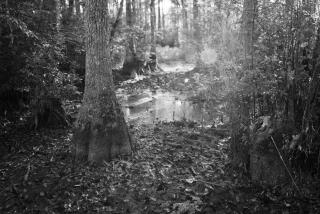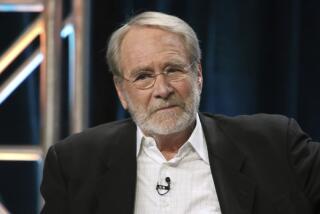A Visionary Who Tried to Slow Down the Traffic
- Share via
Rediscovering America, John Muir in His Time and Ours by Frederick Turner (Viking: $25)
“I care to live only to entice people to look at nature’s loveliness,” John Muir wrote to Jeanne Carr, his patron and close friend. It was his credo. This impassioned, obstinate and independent man, a pioneer in the fight to preserve a part of the American wilderness, would, had he been in Adam’s place, have defied the Lord head-on and not by means of a snake and an apple.
Eden, in Muir’s view--what remained of it in the 1870s--was not something to cultivate and make use of. Rather than taming the natural world, man’s highest purpose was to walk through it, looking.
Son of dour Scots farmer who settled in Wisconsin in 1849, Muir began as a Calvinist and ended up as a kind of pantheist. It was a winding voyage of discovery for this odd and charming visionary. As a boy, he cleared his father’s land and planted his crops. As a young man, he invented a variety of ingenious and curious devices, ranging from an alarm-clock bed--it would tip and dump you on the floor at a prescribed time--to a machine that would turn out thousands of broomsticks in a day.
His professors at the University of Wisconsin prized him as an original. His employers at various mills and factories found him a gold mine of useful as well as quirky ideas. Perhaps there was an early Henry Ford about this tinkerer, but his vision was altogether different. Instead of devising a mass-produced automobile that would subjugate America, he chose to walk, instead, and try to slow down the traffic.
Much Like Daniel Boone
At 29, he left the machines, inscribed “John Muir, Earth-planet, Universe,” and set out on foot from Indianapolis to Savannah. He wanted to explore whatever remained of the Appalachian forest primeval in 1867. He walked through hill hollows and wandered the Great Smokies, much like Daniel Boone, but with a different purpose. As Frederick Turner, author of this new biography, points out, the traditional woodsman was there to bend the forest to himself. Muir was there to bend himself to the forest, to immerse himself in it, to take a wilderness bath.
Then, of course, he went West, invested Yosemite and the High Sierra, explored Utah and Alaska, botanized, spent the night atop 100-foot Douglas firs to listen to the wind, and poured into his notebooks his vision of the wilderness as man’s essential refuge, one that was being extinguished by developers, farmers, miners and lumbermen.
Muir in the already-booming West, like Thoreau on his pond just outside Concord or Huck Finn on the busy Mississippi, asserted a boundless freedom in an encroaching world. But his argument, with the Gilded Age drawing to a close and its cost beginning to be reckoned, caught the mood of the times.
Walked With Emerson
Eastern scientists like Agassiz and Asa Gray encountered him and were impressed. Emerson walked with him and declared this eloquent and hardy seer to be one of “his men.” And Robert Underwood Johnson, an editor of the Century magazine and an early environmental lobbyist, saw in him a human figure and force to give strength to an abstract crusade. Goaded into writing for publication, Muir wrote profusely, and articles in the Century, Harpers and the Atlantic provided some of the fire that led successive Presidents, culminating with Teddy Roosevelt, to set aside land for national parks and forest preserves. Home in California, Muir was a founder of the Sierra Club and became the thundering advocate and defender of Yosemite Park.
In his last years, as Turner writes, “The image of the kindly-faced, white bearded sage who knew wilderness tales had become as much a part of the national consciousness as the image of Buffalo Bill Cody . . . One who could teach a thoroughly modern nation how to love what of the old wild world it had left.”
Muir was America’s nature-object. No statesman could go West without calling on him. Theodore Roosevelt climbed and camped with him. Even William Howard Taft, a national monument of physical unfitness, felt it necessary to visit Yosemite in the company of this wiry and agile old man.
Patron Saint of Purists
Turner’s book gives a detailed account of Muir’s life and vision. He is clear and fair-minded on the essential differences that split the environmental movement three quarters of a century ago and continue to be felt today: between the believers in controlled use of wilderness lands and the purists. Muir, of course, was the latter’s patron saint.
The biography is badly marred, however, by the author’s effort to go beyond his material and recreate every detail of his subject’s feelings at every stage of his life. He calls attention to his purpose and predicts he will be criticized for it. The critics would be right.
There is a deluge, particularly early on, of “would have felts” and “must have felts.” There is a great deal of lush overwriting. Spring “ripens into summer.” Brothels flourish around a military camp “like some rank growth.” With his childhood playmates, Muir “might have heard something more than they did, something inside the raindrops, inside the leaves upon which they fell: a larger music, even a call . . . “ With parts of Muir’s life unrecorded--his relationship with his wife, for example--the author uses a good deal of padding.
Turner’s enthusiasm is admirable. But to make Muir’s vision real to us, he inflates his language to match his subject’s mysticism. Too much of the time he impersonates Muir instead of conveying him. His biography is preemptive.
More to Read
Sign up for The Wild
We’ll help you find the best places to hike, bike and run, as well as the perfect silent spots for meditation and yoga.
You may occasionally receive promotional content from the Los Angeles Times.






